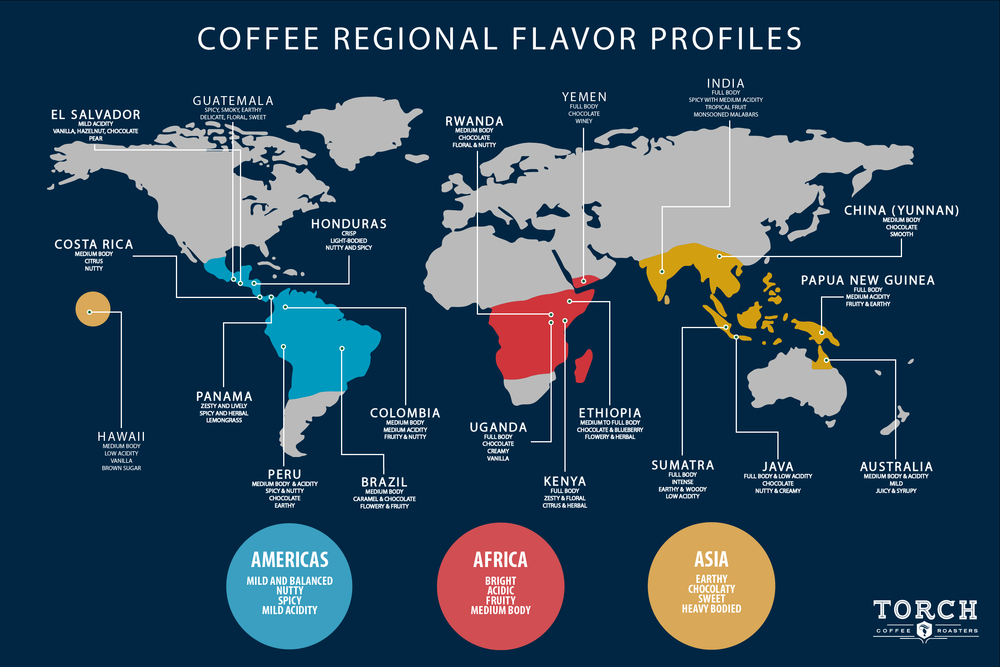Exploring Coffee Growing Regions Around the World
The Global Coffee Economy: An Overview
Coffee, one of the most beloved beverages, has an intricate backstory forged in diverse regions across the globe. This dynamism not only influences the flavor profiles of the coffee produced but also entwines the economies, cultures, and social structures of coffee-growing nations. As a result, understanding the sociopolitical and ecological peculiarities that characterize these regions is crucial for appreciating the complexity of the global coffee economy.
The majority of the world’s coffee is cultivated in the so-called “Coffee Belt,” an area situated between the Tropics of Cancer and Capricorn. Within this geographical cradle, myriad microclimates dictate the unique configurations of flavor that define each region’s output. Factors such as altitude, rainfall, and soil composition contribute equally to the rich tapestry of taste that consumers have come to relish.
Latin America: A Symphony of Flavor
Latin America is home to several notable coffee-growing countries, each offering an exceptional blend of flavor profiles that narrate their respective environmental conditions and cultivation methodologies.
Aromatic Varietals from Colombia
Colombian coffee is renowned worldwide and stands as a paragon of high-quality Arabica beans. The country’s mountainous terrain and diverse climatic conditions foster ideal growing environments. Colombian coffee tends to exude a pleasant acidity paired with a rich body, often accompanied by notes of caramel and citrus. Regions such as Antioquia, Huila, and Caldas are particularly celebrated for their fine-coffee production.
Socioculturally, coffee farming is intertwined with Colombia’s rural heritage. Family-owned farms are common, emphasizing artisanal methods and traditional practices. However, evolving challenges such as climate change and fluctuating market prices complicate the viability of these farms.
The Resilient Character of Brazilian Coffee
Brazil stands as the largest coffee producer globally, offering a stark contrast to Colombia’s specialty focus. Brazilian coffee predominantly features a lower acidity and a robust, chocolatey flavor, often suitable for espresso blends. The diverse growing regions of Minas Gerais and São Paulo ensure a steady supply but face their own set of challenges. The sheer scale of production has led to concerns regarding sustainable practices; the mechanized harvest methods often overlook the labor conditions of workers.
In recent years, however, a burgeoning movement towards sustainability has emerged, encouraging farmers to adopt environmentally sound practices while emphasizing fair trade. This shift resonates deeply with consumers who seek to support ethically sourced products.
Africa: The Birthplace of Coffee
Africa, often referred to as the birthplace of coffee, presents a unique confluence of tradition and innovation. The intricate relationship between the coffee plants and local cultures underscores the significance of coffee as a social element.
Ethiopia: A Cultural Epicenter
Ethiopia is heralded as the cradle of Arabica coffee, possessing an ancient lineage that traces back to the legendary goatherd Kaldi. Ethiopian coffees are globally acclaimed for their diverse flavors—ranging from floral and fruity to full-bodied and spicy—shaped by the varying altitudes and heirloom varietals grown in regions like Yirgacheffe and Sidamo.
Within Ethiopia’s borders, coffee is not merely an agricultural product; it is a lifestyle imbued with cultural practices such as the traditional coffee ceremony. However, Ethiopia faces substantial challenges, including domestic instability and climate changes that affect yield, thus threatening its irreplaceable heritage.
Kenya: A Bold and Fiery Offering
Kenyan coffee is characterized by its vibrant acidity and bold flavors, often highlighted by berry and citrus notes. Predominantly grown in regions such as Nyeri and Kirinyaga, the quality is often assessed through rigorous grading systems. Farmer cooperatives play a vital role in enhancing the quality of coffee while ensuring fair compensation for producers.
Kenya’s approach to coffee cultivation emphasizes quality over quantity, cultivating a sense of pride among growers. Nevertheless, the rising cost of inputs and climatic irregularities cast shadows on the sustainability of the sector.
Asia: The New World of Coffee Production
As we traverse to the Asian continent, the scenario changes yet again. Countries like Vietnam and Indonesia are increasingly making their mark on the global coffee stage, primarily through robusta coffee.
Vietnam: The Robust Champion
Vietnam has emerged as a formidable player in the global coffee market, primarily through its robusta production. With a booming coffee industry, it now ranks second in global production. Vietnamese coffee is typically heavier and less acidic, making it ideal for blended coffee products. The country’s diverse cultivation methods, including unique processing techniques like the use of sweetened condensed milk, have contributed to a distinctive coffee culture.
Despite its success, Vietnamese farmers face the dual challenge of ensuring sustainability while navigating market demands that often favor high-yielding varieties over traditional agricultural practices.
Indonesia: From Island to Cup
Indonesia, characterized by its myriad islands, offers some of the most intriguing coffee varieties, such as Sumatra and Java. Known for their earthy flavors with low acidity, Indonesian coffees provide a unique profile that stands apart in the global marketplace.
The country’s geography plays an essential role in coffee production, with volcanic soils enriching the beans. However, issues such as deforestation and shifting weather patterns threaten the ecological balance, prompting a need for adaptive farming techniques that safeguard both the environment and livelihoods.
The Future of Coffee Growing Regions: Sustainability and Innovation
As climatic changes become more pronounced, coffee-growing regions worldwide are increasingly confronting existential challenges. The implementation of sustainable practices is vital for ensuring the future of coffee cultivation. From organic farming to agroforestry, innovative methods are being encouraged to preserve biodiversity and enhance soil health.
Moreover, the movement towards cooperative farming, fair trade, and transparency in the supply chain reflects a growing awareness among consumers about the implications of their coffee choices. These trends encapsulate a shift towards ethical consumption, where understanding origin and quality becomes essential.
Conclusion: A Global Perspective
The exploration of coffee-growing regions around the world reveals not only the diverse flavor profiles that coffee exhibits but also the intricate socio-economic network that supports its production. From Latin America to Africa and Asia, each coffee-producing country presents a unique narrative intertwined with global consumption patterns and environmental realities.
As we savor our cups of coffee, let us be ever cognizant of the multi-faceted journeys that take place from farm to table—journeys that underscore the resilience and creativity of those who cultivate this cherished beverage.








Leave feedback about this